Optics Handling
Caring for your Laser Optics
Dust and stains on an optic can cause scattering, and impurities on the optic surface can react with incident laser light to damage optical coatings. With proper handling and cleaning of your optics, you can prevent damage and ensure their continued performance.
How to Clean Optics
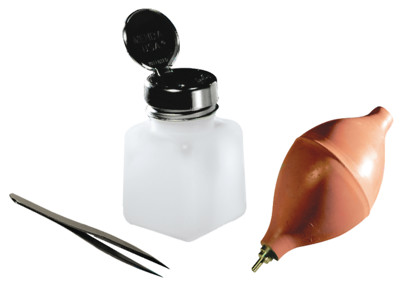
Optic Cleaning Supplies
Removing Dust, Stains and Impurities From Optics
Dust and stains on Optics can cause scattering, and impurities on the optic surface can react with incident laser light to damage optical coatings. With proper handling and cleaning of your optics, you can prevent damage and ensure their continued performance.
General Tips
If it's not dirty, don't clean it! Handling optics increases their chances of getting dirty or damaged, so you should clean optics only when necessary.
You should handle optics in a clean, low-dust environment while wearing powder-free acetone-impenetrable Gloves or Finger Cots. Since oil and debris from your hands or from used Lens Tissue can stain or damage optical coatings, you should not touch any transmissive or reflective surface of your optic and never reuse a lens tissue. Remember that lens tissues are inexpensive compared to the price of an optic
Inspect an optic for dust and stains by holding it near a bright visible-light source. Viewing the optic at different angles allows you to see scattering from dust and stains.
Step 1. Use a clean-air duster:
Dusting is always the first step in cleaning your optics. Wiping a dusty optic is like cleaning it with sandpaper. So always dust with a canned air duster, compressed and filtered air, or nitrogen before wiping any optic. If the dusted optic has no visible stains after you dust it, then remember: “If it's not dirty, don't clean it.” If it's still not clean, proper use of solvents and lens tissue can often do the trick.
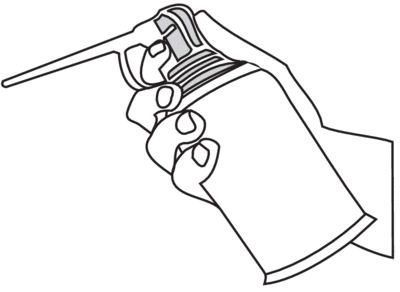
Wiping a dusty optic is like cleaning your windshield with sandpaper. Always blow the dust off your optic with compressed filtered air or nitrogen before further cleaning it.
Step 2. Use solvent and lens tissue:
The way to use them depends on the optic, but always wipe slowly and clean
the edges first.
the edges first.
Glass-cleaning solvents will streak, and tissue paper or a t-shirt will scratch, so always clean optics with reagent- or spectrophotometric-grade solvent and a low-lint tissue manufactured for cleaning optics. Always use lens tissue with a solvent, because dry lens tissue can scratch optical surfaces. A good solvent to use is a mix of 60% acetone† and 40% methanol. (Acetone alone dries too quickly to dissolve all of the debris
The methanol slows the evaporation time, and also dissolves debris that acetone alone would not clean.) Isopropyl alcohol is safe and effective, but its relatively slow evaporation can leave drying marks on the optic. Cleaning your optic's edges before cleaning its faces prevents dirt from being drawn up onto the face. Wiping slowly allows the solvent to evaporate without streaking. Remember, slow and steady cleans the optic.
†NOTE: Always use acetone-impenetrable gloves when using acetone.
The “Drop and Drag” Technique
The “drop and drag” technique is ideal for light cleaning of unmounted optics, such as our Model 51xx mirrors, and Model 580x beam pick-offs
Place your optic on a clean, non-abrasive surface, such as a clean-room wiper. After blowing off the dust using compressed air or nitrogen, lay a piece of unfolded lens tissue over the optic, drop on some solvent, and slowly drag the soaked tissue across the optic's face.
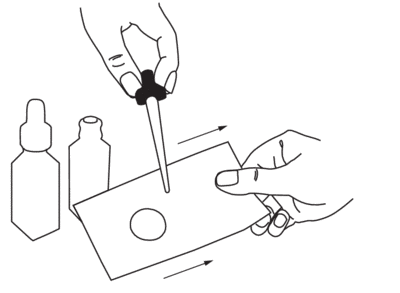
Drop solvent onto your lens paper and drag the soaked tissue slowly across the optic's face. Remember to clean the edges of your optic before you clean the face.
The “Brush” Technique
Use the “brush” technique for small optics, such as our Model 515x mirrors and 581x beamsplitter cubes.
Wipe slowly straight across from one edge of the optic to the other.
Wipe slowly straight across from one edge of the optic to the other.
Make a lens-tissue brush by folding the lens tissue so that the fold is as wide as the optic to be cleaned. Do not touch any part of the tissue that will touch the optic. With a hemostat or tweezers, grip the folded tissue parallel to and near the fold. Wet the “brush” with acetone and shake off any excess liquid.
Blow off the dust. Place the brush on the optic surface, apply slight pressure with the hemostat, and slowly wipe straight across, from one edge of the optic surface to another.
†NOTE: When cleaning Model 581X beamsplitter cubes, avoid getting solvent into the gap between the two prisms that make up the cubes, as this will break the bond between them.
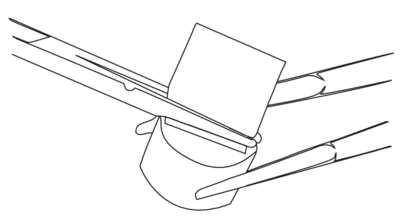
Wipe slowly straight across from one edge of the optic to the other.
The “Brush” Technique for Small-Diameter or Mounted Optics
You can use a modified “brush” technique for small-diameter or mounted optics. This technique is ideal for our Models 5511 and 552x polarizers, Models 554x wave plates, and Model 572x-H aspheric lenses.
For these optics with hard-to-reach edges, make a small brush by wrapping an optic tissue around the soft tip of a synthetic low-lint swab. In one motion, “paint” the optic perimeter and sweep across the center of the optic. Wiping in a continuous motion prevents drying marks.
The “Wipe” Technique
(not recommended for metallic coatings)
This method is useful for heavier cleaning of stubborn stains. Fold the lens tissue as described in the “brush” technique above, and grip it with your fingers instead of the hemostat.
Applying a uniform pressure on the optic edge, slowly wipe across the optic's face.
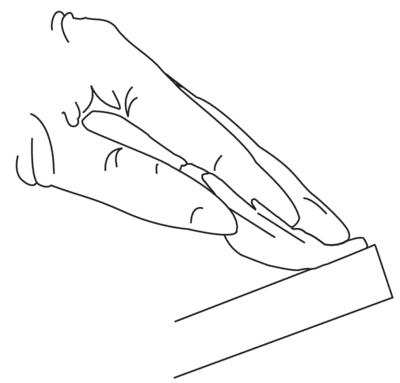
Use the “wipe” technique to remove stubborn stains on more durable coatings.
The “Immersion” Technique
For softer coatings, which damage more easily, we recommend using the “immersion” technique. Simply remove any dust from the optic and then immerse it in acetone. If the optic is very dirty, you can use an ultrasonic bath. Rinse and immerse the optic in fresh solvent a number of times until it's clean. To dry the optic, carefully blow the solvent off from one direction to avoid leaving drying marks.
Once You Have Cleaned Your Optic
Place the optic in the mount it will be used in or wrap it in lens tissue and place it in its container right away.
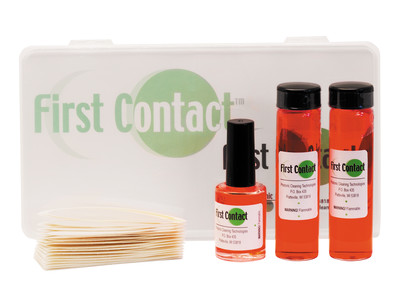
Model RFCR red polymer optic cleaning kit
Advanced Optic Cleaning with Polymer Film
While the above optic cleaning methods work well for cleaning optics, if you want an optic clean to the atomic level without any risk of scratching or damaging your optic, a polymer optic cleaning solution is the way to go. With a polymer optic cleaner, you pour, brush or spray a designer polymer on the optic. As the polymer dries to a film, organic compounds are dissolved and particulates are encapsulated by the polymer. Peeling off the polymer film reveals a pristine optic surface that is as clean as or cleaner than new. Polymer optic cleaners can also be used on rough surfaces and gratings which can be difficult or impossible to clean using standard techniques.


